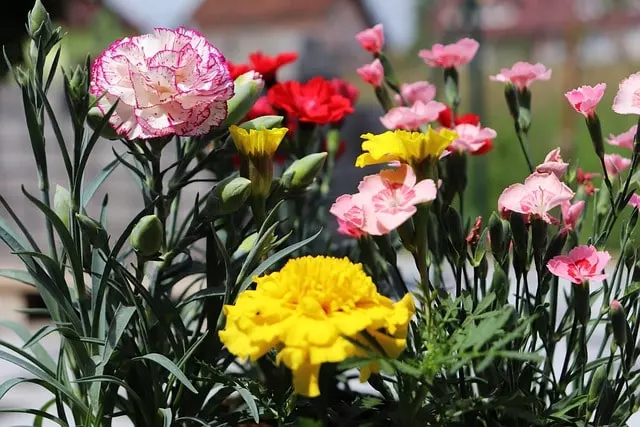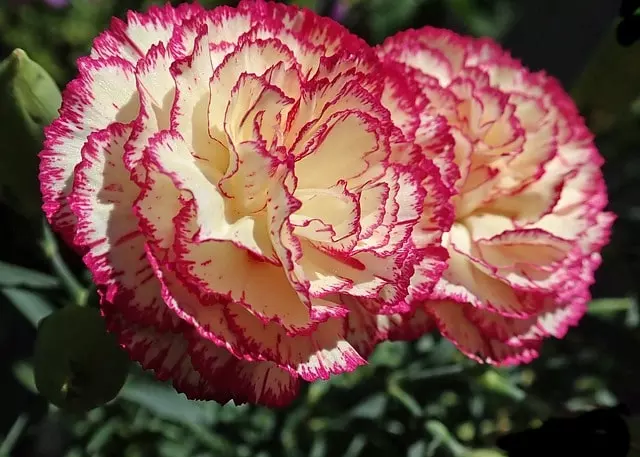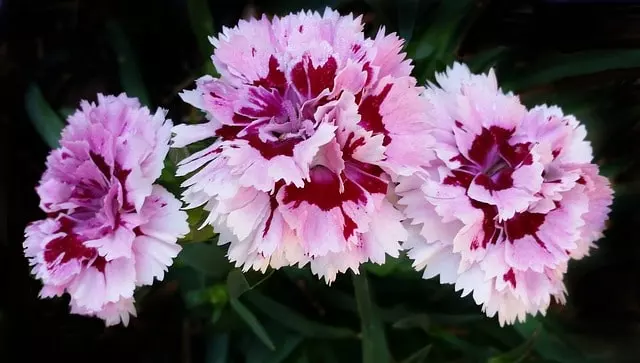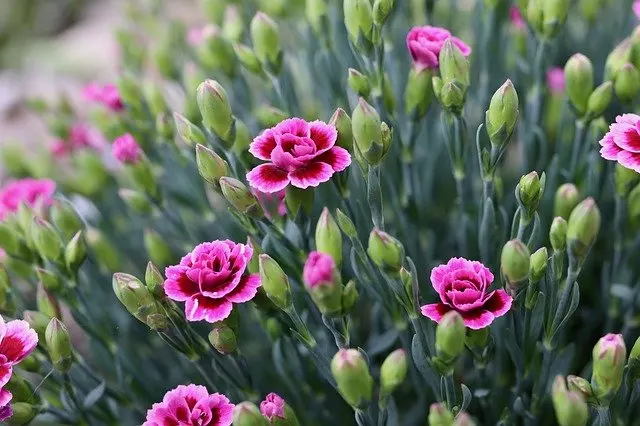This article is intended to be a guide on the process of how to grow carnations. Carnation is a plant that comes to be considered easy to grow. They can grow from 7” to 9” (18 to 24 cm) in height, depending on the variety used, and are capable of producing an exquisite spicy clove fragrance.
There are currently more than 300 species of carnations and hundreds of other hybrid varieties. Generally, carnation refers to the plant known scientifically as Dianthus caryophyllus.
These are attractive plants that produce flowers in a variety of colors, including white, red, and pink. However, it can also feature hybrid species whose flowers are of various colors.
Some basic care on how to plant carnations is to know that these can come as annual, biennial, and perennial varieties. Carnations can be grown in beds, borders, rock gardens, and even containers such as pots. Some varieties can even bloom during fall; as long as they are sheltered from inclement weather.
Although carnations do not require a lot of labor, there is some care we must take with carnations that must be considered, since the better the care of the carnation the better the growth of this beautiful flower will be.

Table of Contents
Factors To Consider in Knowing How to Grow Carnations
Some of the main factors that affect carnation growth are listed below:
When To Plant a Carnation Plant?
Six to eight weeks before the final frost, start sowing carnation seeds inside. Outdoors, on the other hand, it is preferred to plant carnations when the danger of frost has passed. While indoors the plant is very likely to bloom the first year, if the seed has been sown outdoors it is unlikely that the plant will bloom during this year.
As far as lighting is concerned, carnations need to be in full sun and receive an average of 4 to 5 hours of sunlight per day.
Soil
The soil should have good drainage. Mulching is not best suited for this plant because it requires adequate air circulation. Carnations are easy to care for and thrive in fertile, well-drained soil with a soil pH of 6.75, slightly alkaline. Learn more about How to Measure Soil pH.

Watering
One thing to bear in mind when learning how to grow carnations is that, except for the summer months, this plant does not require much water. Because it is a plant that is sensitive to excess moisture, it is critical to take specific precautions to keep the soil from becoming too wet. Watering should be done in the early morning or late at night.
Temperature and Lighting
The temperature is suitable for the growth and reproduction of carnations, ranging between 46 and 77 °F (8 °C – 25 °C). The optimum temperature in winter should be between 59 and 64 °F (15° and 18° C) during the day and 50 to 54 °F (10° to 12° C) at night. While in summer the ideal temperature would be 70 °F (21° C) during the day and 54 °F (12° C) at night.

How to Grow Carnations Step by Step
How To Grow Carnations from Seed
Seeds can be sown in a seedbed, just sprinkle them on top of the substrate and cover them lightly. Watering in the seedbed should be done with the help of a sprayer, and then cover the seedbed with a transparent plastic bag to create a greenhouse effect.
The plants in the seedbed should be transplanted to their pots when they have two to three leaves. If you want to transplant them outdoors, they should be transplanted when they are 4 to 5 inches tall (10 to 12 cm).
You should also sow carnations from their seeds in the final place, although it is recommended to do it in seedbeds to save time and facilitate their handling. The depth to place the seeds outdoors is 1/8 of an inch. Another point to keep in mind is that the soil must be well-drained, you must also make sure to keep the soil moist but not waterlogged.
Once the carnation plants are sufficiently resistant they should be placed 5” (12 cm) apart, leaving only the strongest plants.

How To Grow Carnations from Cuttings
The first step in propagating a carnation cutting is to disinfect the scissors you will use to cut the plant. The cut is made leaving a cutting that has 6 to 7 nodes. Then remove the leaves that are going to be buried under the soil, approximately 3 to 4 knots. The part to be buried should be placed in growth hormones to be subsequently buried in the place where it will grow.
The cuttings are inserted into the soil avoiding the lower leaves to come in contact with the soil surface. If you have placed the cutting in a pot, the plant should be ready to be transplanted after 25 to 30 days.
Potting Carnations
Grow carnations in pots starts by choosing a container that has some drainage holes because it hates waterlogging. You should introduce some stones at the bottom of the pot to improve drainage. The pot should be filled with a universal substrate enriched with organic matter, such as worm castings.

Carnations Care, Pests, and Diseases
Mulching is not recommended for carnations because it can prevent proper air circulation in the carnation stems. Something that could have an impact on its growth because it needs to be kept dry.
Peat is an excellent organic material that can be used to encourage carnation growth. Pulverized pine bark and rotting cow manure can also be used as compost.
However, before determining what type of manure to utilize outside, a soil analysis should be performed. This is because soil very rich in manure or with high levels of nitrogen is not the most suitable for carnation as it can cause very heavy vegetative growth, flower shortage, or calyx splitting.
Insects and diseases: A point that does not become of much importance in this guide on how to plant carnations because insect and disease problems are rare. In case of insect or disease problems, early treatment with potassium soap or neem oil can be extremely helpful.
Taking care of the size: It is necessary to know in advance what will be the size of the variety we are going to plant to provide adequate support. The support should be fixed in place shortly after planting.
We hope this article on how to grow carnations will be useful. We recommend our article about How to Care for Vinca Flowers.
- Dianthus caryophyllus, or Carnation, is one of the most popular flowers ever grown. They are perfect for the cutting garden as they grow to a height of 24 inches and have strong stems growing as a perennial in USDA zones 6 - 9.
- This Chabaud mix has colors of violet, purple, red, pink, orange, and yellow, and they all have the terrific spicy-sweet fragrance that is so well-known to Carnations.
- The foliage is grayish-green, and this plant enjoys a position in full sun.
- ✔ Quality seeds packaged by MySeeds.Co All seeds sold by MySeeds.Co are Non-GMO based seed products and are intended for the current & the following growing season. "All seeds are produced from open pollinated plants, stored in a temperature controlled facility and constantly moved out due to popularity.
- ✔ Dianthus caryophyllus, the carnation or clove carnation, is a species of Dianthus
- ✔ It is native to the Mediterranean region



